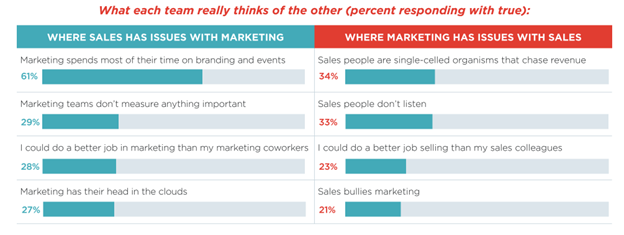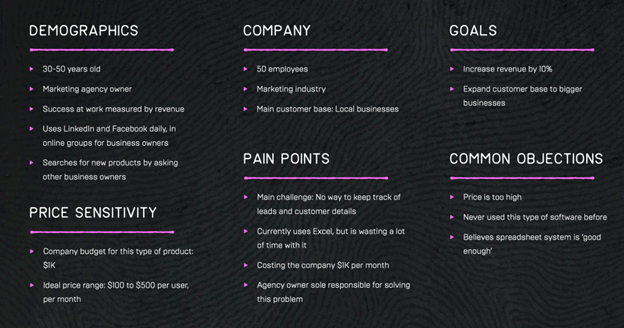
4 Strategies for Improving Sales and Marketing Alignment
It's hard to imagine a heavyweight like IBM ever had issues with its internal teams.
Before its sales and marketing teams were aligned, they operated in silos.
Its sales teams had blinkers on: they needed to fulfill product demand, get qualified leads, and hit targets.
Anything else wasn't even on their radar. But its marketing teams were only worried about advertising dollars and messaging campaigns.
The marketing team would launch a new product without consulting the sales team, which created silos and left them unable to capitalize on sales.
So, what changed? 🤔
Simple. The two teams got on the same page, built out a strategy, and worked together to close deals.
Aligning sales and marketing doesn't always mean scrapping your current process and starting from scratch.
Some tweaks to your tech stack (like adding a CRM ) or a monthly meeting may be all it takes to break down barriers between your teams and improve customer experience.
Let's take a look at why sales and marketing alignment matters and our top strategies to get it right.
Why Does Sales And Marketing Alignment Matter?
Milk and cookies. Peanut butter and jelly. Sales and marketing.
Some things just work well together.
Let's start with the numbers around sales and marketing alignment.
Studies show companies with good alignment will grow 27% faster over three years compared to those that don't.
And then there's the sales wins: the same study found aligned teams close 38% more deals.
Yet sales and marketing working together mean more than sales numbers. If your teams are aligned, it leads to a ton of other benefits, like:
Better communication + efficiency
When teams are jelling, a salesperson can ping a marketing rep on Slack to ask for some help with a customer success story or case study.
Better yet, aligned teams have access to the same information, so the sales rep can jump into a shared Cloud drive to find what they're looking for and save time.
Killer customer experience
No more bumps in the pipeline. Aligned sales and marketing teams can pass off leads at the right time and ensure customers have a cohesive experience.
Not only will customers get consistent messaging, they won't have any communication gaps and can build trust with your reps.
Shorter sales cycle
Give sales reps back their time to hunt out more deals.
An alignment sales + marketing machine can improve the quality of leads flowing into your sales funnel and save your reps time following up dead ends.
Better marketing ROI
Your sales team can communicate to your marketing team and explain exactly what they need to close a deal.
With marketing activities in sync with sales reps, lead generation efforts like product launches and case studies can be tweaked to bring in more paying customers.
But what happens if sales and marketing aren't aligned? How does it affect your company when your teams… just aren't in sync?
Between 3 to 9 percent of teams describe their relationship with the phrase “at each other’s throat”.

Well, it can impact your customer's buying journey and make you lose out on business.
If departments aren't working together, it's easy for leads to get inconsistent information about a product or offer.
Even worse, customers can slip through the cracks and end up going to a competitor.
Aligning Sales and Marketing: 4 Winning Strategies
Aligning sales and marketing teams sounds easy enough on paper.
But what does it look like in real life? 🤔
For most companies, it's about building a bridge so it's easy for departments to collaborate, share information, and see what's landing with customers.
Here are my four best strategies to get your sales and marketing working like a fine-tuned machine 👇
Set Goals Together
Think about what your sales reps consider a win. And now do the same for your marketing team.
Are the answers similar? Or did they land in completely different ballparks? 😬
A look at common complaints teams have of their respective counterpart reveals that they often don’t even agree on what’s important:

At the end of the day, sales and marketing teams can only be truly aligned when they aim for the same goal.
You must define in black and white what KPIs and metrics the company expects and create some shared goals for both departments to aim for.
We're talking about things like:
Leads generated / conversion rates
The number of new leads generated by marketing campaigns doesn't always lead to paying customers.
Marketing must understand how many leads are converting into customers (or not) and how effective their lead-generation efforts are.
For example, if there's a big gap between generated leads and conversion rates, it may signal a problem with campaign targeting.
Cost per Lead (CPL) / average deal size
How much is the marketing team spending to bring a new lead into the sales funnel?
An expensive push on Linkedin may have pulled in 1000 new leads.
But if the campaign cost $10,000 and the average deal size is only $10, the company may have lost money after factoring in the cost of salaries and time.
Both teams must understand the ROI and average deal size of each campaign to calculate the profitability of their sales and marketing efforts.
Engagement / customer retention
Marketing campaigns can have a million likes and shares… but how many customers are actually sticking around?
Vanity metrics can be kryptonite for marketing teams and make them focus on activities that aren't tied to customer retention.
Focus your sales and marketing on metrics like click-through rates, open rates, conversions, and overall retention, so they can see how many customers are staying with you.
This will help the teams see that some metrics they think are important may not actually be doing much for KPIs like deal sizes of conversions.
By using the same language, every team can connect campaigns and sales activity to the ultimate goal: more paying customers.
Collaborate to Create Buyer Personas
Ever heard the phrase… if you try to sell to everyone, you'll end up selling to no one?
It's true.
A buyer persona aligns sales and marketing and gives them a roadmap to future customers. It tells them where your customers live.
What their needs are. And most importantly, what they want out of a product.
The fatal mistake most companies make is putting marketing teams solely in charge of creating buyer personas without getting any input from the sales team.
Marketers build out personas based on what they think is a prospect's specific needs, personality and preferences.
But sales teams usually have a more detailed insight into their objections and challenges. Without this information, it's hard to create a fully-rounded buyer persona.
Let's use an example of a SaaS company that sells CRM to boutique agencies.
They need to figure out their ideal buyer's demographics, company size, goals, pain points, common objections, decision factors, and budget.
To do it, their marketing and sales team should come together and ask:
Demographics: What is the decision maker's age, gender, location, income and education?
Company size: How many employees does the company have? What industry does it work in? Who is their main customer base?
Goals: What are the company’s goals for this quarter or year? What are the company’s long-term goals? How does the CRM help the prospect's company reach those goals?
Challenges: What are the main challenges they face in reaching their goals? How does the CRM help them overcome those challenges?
Use of product: Which CRM features do current customers use every day? Which features hardly ever get used? Do the CRM features live up to customer expectations? How does each feature help customers do their job better? How much ROI are customers getting from the CRM?
Budget: How much budget does the company have for software? At what price would they consider a CRM to be so expensive that you wouldn't consider buying it? And at what price would a CRM seem so cheap that they second-guess its quality?
Decision factors: Who makes purchasing decisions for the company? Did they use another CRM software before deciding to test out this one? If so, why did they switch?
Common objections: What main concerns did customers have about purchasing a CRM? Which features do customers think are missing?
Your marketing and sales teams should answer the questions in enough detail that you're left with a detailed buyer persona that looks like this:
The icing on the cake when creating a buyer persona is to include a quick elevator pitch that aligns both teams on the product's usage.

For this example, it could be something like:
“Our niche CRM is easier to use than a spreadsheet: agency owners save time and have more insights into current deals and customers to sell more packages.”
This common message can keep marketing and sales teams aligned with messaging when moving a new prospect through the sales funnel.
Host Monthly Cross-Team Meetings
Look, we're not a company that loves team meetings.
Our team at Close mainly collaborates over Slack and project management tools to keep everything on track.
But every once in a while, we need to chew the fat and get on the same page.
And we've found the best way to do it is a monthly cross-team smarketing (sales + marketing) meeting that analyzes everything from upcoming feature launches to shared goals and KIPs.
We usually cover:
Hitting SLAs: Service level agreements (SLAs) are a contract that states expectations for marketing and sales teams.
It lays out the goals and performance expectations for both teams.
Cross-collaboration ideas: If our sales team needs more sales enablement content, like case studies or customer success stories, this is the place to ask for it.
For example, a specific case study may have helped our sales team overcome objections when closing a deal in a specific industry.
The marketing department can then use it in future messaging to dampen customer objections and speed up the sales process.
Without the sales team's input, the marketing team may have never used the case study in its campaign!
Useful feedback: Is certain sales enablement content working really well between departments?
Or has there been a campaign that's fallen flat because the messaging in an email marketing campaign didn't align with the buyer persona the sales team is targeting?
Our cross-team meetings are the best place to be honest about what's working and what's not.
It helps us pivot back to activities that will bring in more customers instead of wasting time on the wrong target customers or failed campaigns.
It's only an hour out of everyone's calendar each month. However, our monthly cross-team meetings are probably the best tool in our toolkit for keeping sales and marketing teams on the same page.
Use Tools that Support Sales/Marketing Alignment
A company's tech stack is its foundation for growth. It can help teams sell better, improve productivity and talk to each other.
So if you don't have the right sales tools in place, not only is it hard for your team to sell efficiently, it'll be near impossible for them to collaborate with your marketing reps.
It all starts with the customer's first touch with your brand.
Did they find you on LinkedIn? Or Google? An event you hosted? (Tools like Modern Events Calendar help you host successful events with ease.)
Upgrade Your Event Management
Ready to take your event management to the next level? Look no further than Modern Events Calendar – the best WordPress event calendar plugin on the market.
And how engaged are they with your brand? Has the marketing team started to nurture them?
Yeah, it's a lot. And it's easy to see how sales and marketing handle lead handovers if customer journeys are not tracked effectively.
This is where investing in the right sales and marketing tools makes all the difference.
But the big elephant in the room is that a lot of tools on the market usually focus on sales or marketing, not sales and marketing.
Look for a tool that has the basics for sales and marketing alignment:
👩💻 CRM: A reliable CRM is the bridge between sales and marketing.
Its central location tracks and stores customer data, and both teams can access it to make notes on deal progression.
Think of it as a single source of truth for customer information.
⚡ Lead management: You need an easy, measured way for marketing teams to pass over prospective leads and deals to your sales team.
It's ideal to have a platform that allows both teams to view deal progress, past communication, and customer information to prioritize leads based on their conversion potential.
🤝 Collab tools: Calendar? Slack? Shared folders? Yep, these can all break down silos between sales and marketing departments.
Give each team the tools it needs to sync with effective communication, customer data, and information.
📈 Metrics + tracking: Finally, make sure your tools get into the weeds of each deal that is in the pipeline.
We're talking about tracking key marketing and sales metrics like lead generation, conversion rates, engagement metrics, deal close rates, and ROI.
A healthy mix of metrics across each department helps both teams see how dollars are spent and what impact their efforts have on revenue.
All of these are basic, out-of-the-box features for sales tools or marketing software. But only a couple of platforms will offer them all under one roof.
My advice?
Do your homework. Find a tool that will align your departments using a mix of out-of-the-box features and native/no-code integrations so you don't spend weeks building an expensive tech stack from scratch.
Ready for Your Sales and Marketing Teams to Work Together?
Successful, growing companies have one thing in common: they work well together and know the customers like the back of their hand.
The marketing team will provide sales with content that will help them close deals, and the sales team will have access to important customer data at any time. In some cases, companies even turn to outsourced sales development solutions to ensure their teams are equipped with the right tools and expertise from day one
Creating true sales and marketing alignment starts with being honest about your current processes.
There may be barriers that you have (accidentally) put in place that are stopping your teams from collaborating.
It may be small, like not using the right communication tools or CRM database. Or there may be bigger silos to break down, like not having regular meetings or any shared goals.
Audit your processes, see where the problems are between your teams and start building a bridge so they can work together.
Your company's bottom line—and most importantly your customers—will thank you for it.
Recommended Posts

The Ultimate Guide to Effortlessly Automate SMS Notifications on Your WordPress Website in 2025
April 4, 2025

Top 5 Email Marketing Tools for Event Promotion in 2025
January 21, 2025

Venue Marketing Tips to Boost Ticket Sales for Events in 2025
December 22, 2024
